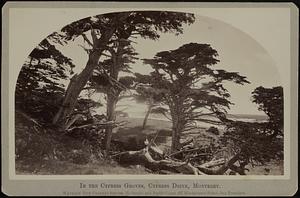Boston Public Library
Cabinet Card Collection

Detail from:
Bearded man in Grecian costume aiming rifle
The cabinet card was a photographic format popular in the late 19th century. It consisted of a photograph mounted to a standard 4¼ x 6½ inch cardboard mount. The cabinet card was introduced in the early 1860s as a larger version of the original standard-mounted photograph -- the wildly popular carte de visite. By 1870, the cabinet card had largely supplanted the carte de visite to become the dominant photographic format for portraiture. Cabinet cards also served as advertisements for the photographers, as the studio would be credited on the back of the card with elaborately printed and embossed decorative credits and logos.
From the 1870s through 1900, people collected cabinet card portraits of family and friends to be displayed in their homes or in albums designed specifically for cabinet cards. Cabinet card portraits of famous politicians, entertainers, and athletes were printed in large numbers and sold to the public, helping to create a market for celebrity memorabilia.
Although cabinet cards continued to be produced into the 20th century -- and even larger mounted formats like the boudoir and imperial card were developed -- various factors contributed to undercutting the business model for selling standard-sized mounted cards. With the invention of personal snapshot photography and the introduction of the Kodak box camera, people could photograph their family and friends with their own cameras and did not need to purchase professional studio portraits. And, by the early 20th century, photographic papers no longer needed the extra support of the mount to protect the image. With larger print sizes like the 8- x 10-inch print becoming popular, the cost of mounting larger images was no longer feasible.
Critical funding to support long-term preservation of and enhanced public access to Boston Public Library collections, including this one, was provided by the Associates of the Boston Public Library.
From the 1870s through 1900, people collected cabinet card portraits of family and friends to be displayed in their homes or in albums designed specifically for cabinet cards. Cabinet card portraits of famous politicians, entertainers, and athletes were printed in large numbers and sold to the public, helping to create a market for celebrity memorabilia.
Although cabinet cards continued to be produced into the 20th century -- and even larger mounted formats like the boudoir and imperial card were developed -- various factors contributed to undercutting the business model for selling standard-sized mounted cards. With the invention of personal snapshot photography and the introduction of the Kodak box camera, people could photograph their family and friends with their own cameras and did not need to purchase professional studio portraits. And, by the early 20th century, photographic papers no longer needed the extra support of the mount to protect the image. With larger print sizes like the 8- x 10-inch print becoming popular, the cost of mounting larger images was no longer feasible.
Critical funding to support long-term preservation of and enhanced public access to Boston Public Library collections, including this one, was provided by the Associates of the Boston Public Library.

